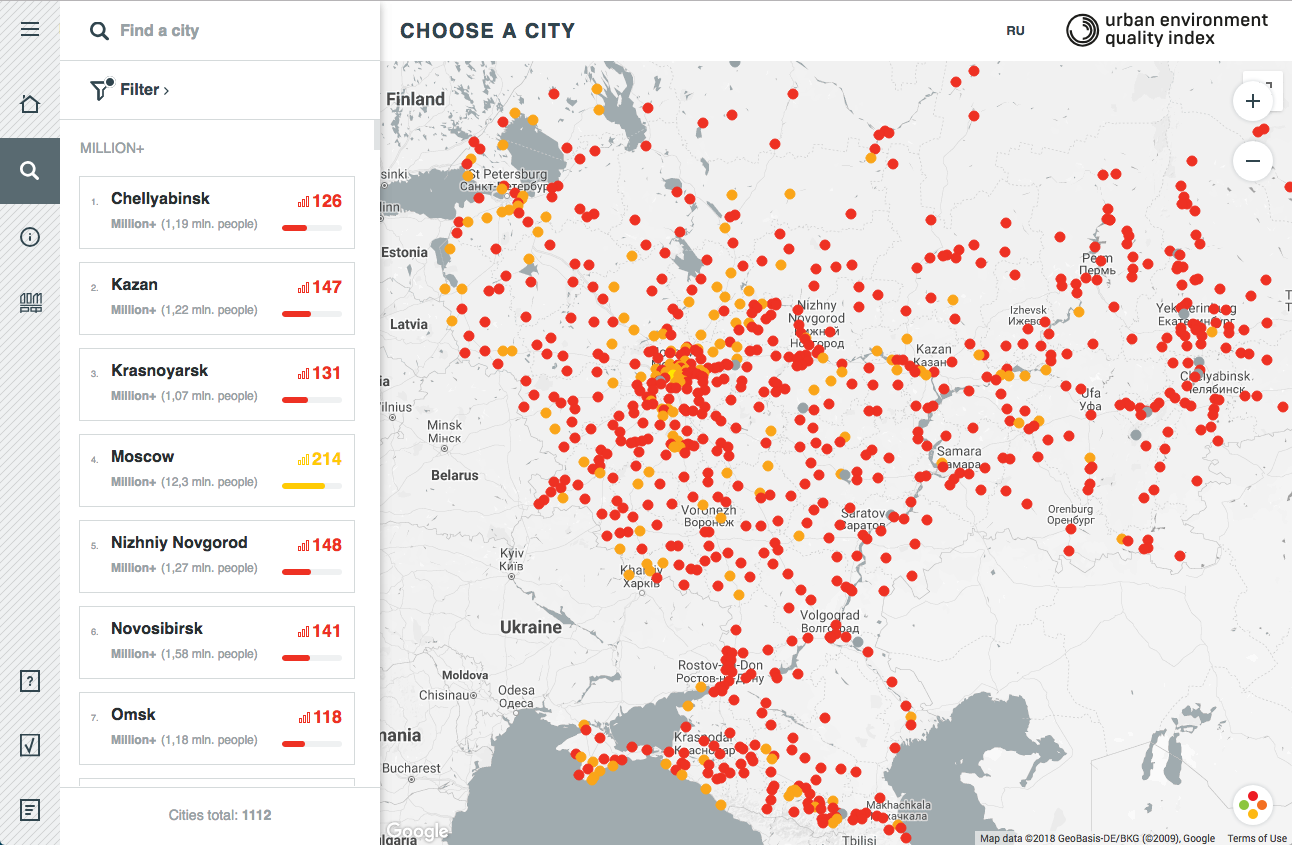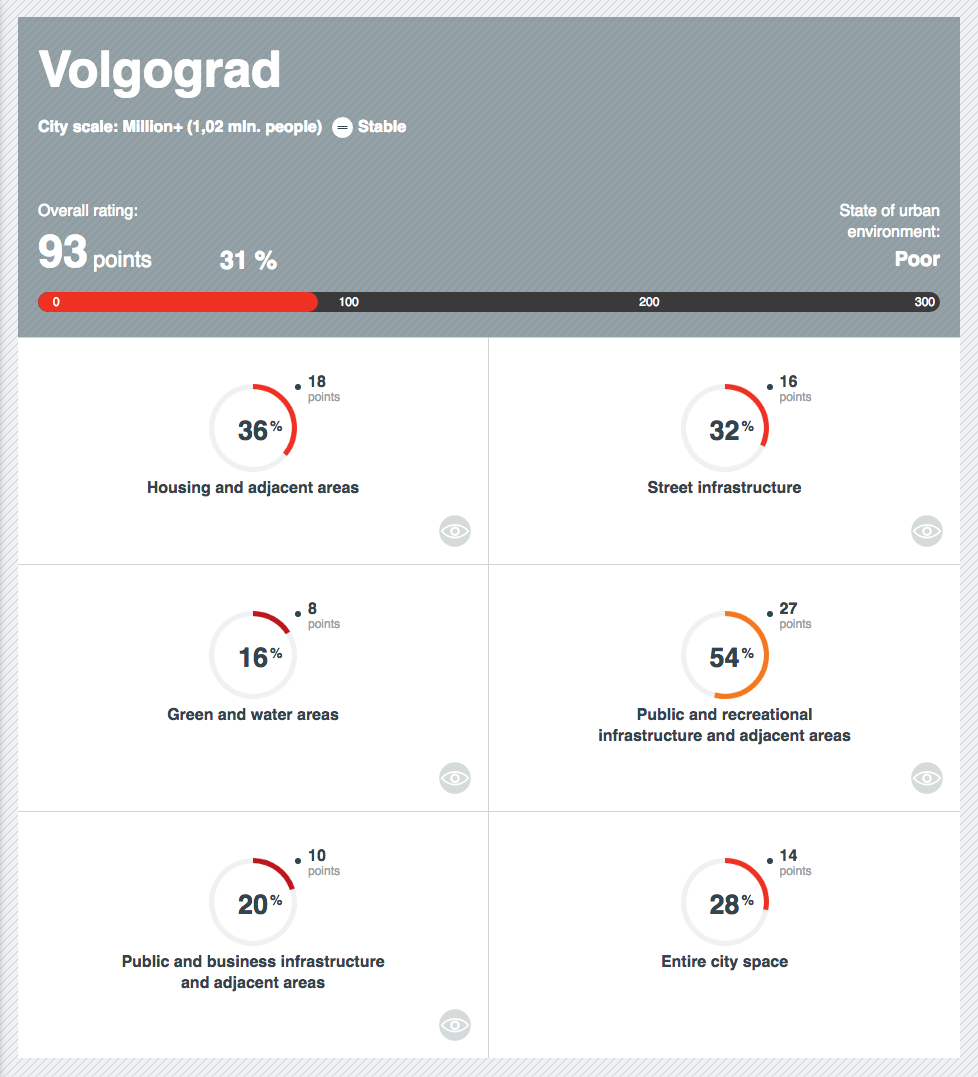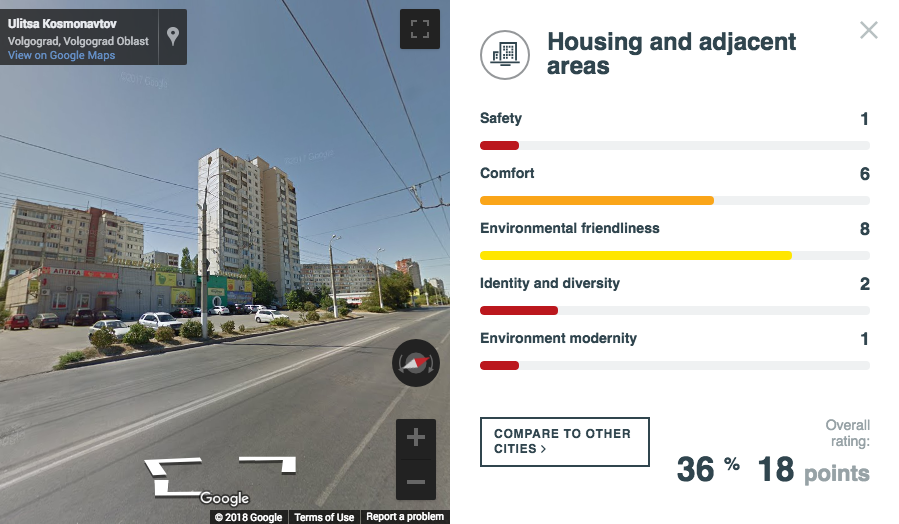
Image source: Strelka KB
4CITIES alum Victoria Remezkova (Cohort 07) has had her hands full lately. Field Notes caught up with her to talk about her involvement in a massive project that attempted to devise an urban environment quality index and apply it to every city in Russia.
EDITOR’S NOTE: the decision to designate cities in Crimea as “Russian” was made by the research team. The sharing of this research by 4CITIES is not a declaration in support of this decision. Our objective here is to highlight the work of 4CITIES alumni.
Here’s a short description of the project from Strelka:
Volgograd, Perm, and Samara are the three major Russian cities with the lowest urban environment quality scores, according to a new index. The first is in the worst shape: the state of all types of urban spaces in Volgograd was found to be unsatisfactory. However, there’s also some good news: now anyone can delve into the city’s problems and find out what exactly is wrong.
The Urban Environment Quality Index was developed by Strelka KB experts: sociologists, geographers, economists, and GIS analysts, who conduct geospatial analysis. The index was commissioned by the foundation of the Unified Institute for Housing Development of the Agency for Housing Mortgage Lending. The work began in October 2016 and took about 10 months to complete. According to the director of the project, Anastasia Shcherbakova, it’s the first tool in the whole country that can assess all 1,112 Russian cities. Now, as a trial run, specialists have assessed all the cities with a population of more than 250,000 people.

Image: urbanindex.ru
Here’s Victoria: “I received a job offer from Strelka KB on the 31st of December after graduating from 4CITIES and the moment the holidays ended we jumped into the Index creation. At that moment, I did not fully understand that that’s how I would spend the whole year. Nor did I realize that there were no less than 1112 cities in Russia for which the Index score was supposed to be calculated. The Index was my very first project at a full-time job – and turned out to be the biggest and my favorite.
“Our team consisted of an economic geographer, a sociologist, and an urban planner, with an average age of 24. In the beginning we had fun times coming up with an overall concept and ideology behind the project. That fun faded a bit when it came time to select 30 indicators that could be calculated remotely and for all Russian cities. The sad truth was that urban statistics in Russia are really underdeveloped. All imaginable data exists for the regions, but almost none for all 1112 cities.
“Finally, we managed to scratch half of the data from the official statistics (this was soooo not open data), and the other half we got from GIS. It took the whole GIS department four months to calculate the indicators for 1,000+ cities.”
Strelka: The project’s creators pay attention to terminology and ask people not to call the index a rating. It wasn’t their goal to put cities in a specific order and announce a leader. The Urban Environment Quality Index is a system that first and foremost, makes it possible to examine the state of populated areas in detail and to reveal their weak spots.
A matrix was developed for assessing cities. Every city’s final score is made on the basis of six indicators, each representing a certain type of space: “housing and adjacent spaces”, “street infrastructure”, “greening and water spaces”, “social-leisure infrastructure and adjacent spaces”, “public-business infrastructure and adjacent spaces,” and “citywide space”. Each one is assessed based on five criteria: security, comfort, ecological properties, identity and versatility, and also how modern the environment is. The scores were determined based on the indicators using particular urban data. For example, the level of security of the public and business infrastructure of the city depends on the illumination of the streets, lobbies, and embankments. If that parameter turns out to be low, the city needs to focus on security. The data for every indicator is evaluated on a scale of one to 10. The sum of the scores for every criterion is then added up to make the total score for the city.


Images: urbanindex.ru
Victoria: “In the end, the Index was born, and as far as I know it was the first time in the world that someone created an index to evaluate the quality of the urban environment in ALL the cities and towns of a country, regardless of their size and importance.
“For the Russian government, the results were quite eye-opening. It turned out that most of the Russian cities had poor and outdated urban environments. So the government issued a directive for the cities’ administrations to improve their Index scores within five years by fixing the problems pointed out by our indicators. So if in five years (though I’ll be glad even if it takes 50 years) Russian cities become a slightly better place, we’ll be some super proud urbanists.”


